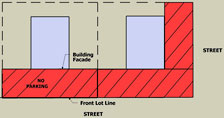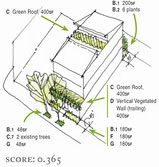Green Area ratio hearing, parking testimony deadline today
DC’s extensive zoning update process continues with a hearing tonight on the Green Area Ratio proposals and the deadline for submitting written comments on car and bicycle parking minimums and maximums.
First, today is the last day to submit written testimony to the Zoning Commission on the parking chapter, including relaxing parking minimums, adding limited parking maximums for very large projects, and guiding the location of parking on a lot.
I’m particularly focusing my written comments on the need to accelerate section 1506 (PDF) of the parking proposal, which disallows putting parking in front of buildings. OP and the Zoning Commission should enact this section before the complete zoning rewrite takes effect over a year from now.
Projects like the Aldi in Carver-Langston or the Van Ness Walgreens (later changed) will keep getting proposed while the zoning rewrite is underway. Developers will design a project the way zoning requires, but in the absence of guidance, they’ll just fall back on the standard suburban models. These projects will last for 50 years, so the least we can ask is that the developer put the parking behind the buildings.
To submit comments, fax or emailed a signed PDF of not more than 10 pages to zcsubmissions@dc.gov by 3 pm today.
The Green Area Ratio (PDF), the subject of tonight’s hearing, incorporates a standard of environmental sustainability into development. New development or large-scale renovations for buildings will have to meet a GAR standard, except for single-family homes, 2-unit condos/apartments, or accessory dwellings .
The proposed text sets scores for different kinds of landscaping and stormwater management. Trees count for a certain number of square feet depending on their size. Landscaped areas count for 30-60% of their size depending on the depth of their soil, permeable pavers about 40-50%, green roofs 60-80%. That score is then divided by the total size of the lot to generate a GAR.
The actual GAR each property will have to achieve has yet to be determined, and the Office of Planning will propose specific thresholds as they write zoning text for each individual type of zone.
Implementing the GAR will cost some money, though statistics from a similar program in Seattle showed that it added only ½% to 1% to the total cost of the project. In addition, buildings have to pay impervious surface fees from the District Department of the Environment and DC Water, and higher GAR will directly lower those payments. GAR features on buildings will also help DC reach its EPA-mandated stormwater quality goals, improve air quality, and reduce air conditioning costs.
OP estimated the current GAR of properties in DC. For commercial zones, the GAR today falls between .2 and .3, with industrial zones a little lower, moderate density residential between .3 and .4, and lower density residential zones higher due to their lower lot coverage.
The Zoning Commission asked OP to estimate what GAR requirements it might set for a zone. OPS ran the analysis for Production, Distribution and Repair (PDR) zones, which are designated C-M for Commercial and Manufacturing or just M for Manufacturing in the old zoning code. PDR zones average .137, the lowest category in DC.
Each 0.1 of GAR would add about $1.50 per square foot to projects. OP would recommend a starting GAR requirement of 0.2, with the opportunity to reevaluate raising the threshold in the future. This would add less than 1% to the construction costs of new projects.
The hearing is tonight, 6:30 pm at 441 4th Street, NW (One Judiciary Square), room 220-South. Typically in these hearings, OP presents first, then the Zoning Commission asks questions, and finally public witnesses can speak, first witnesses in support and then those opposed. Fill out two of the little witness cards that are on the table next to the far right door while you wait.


